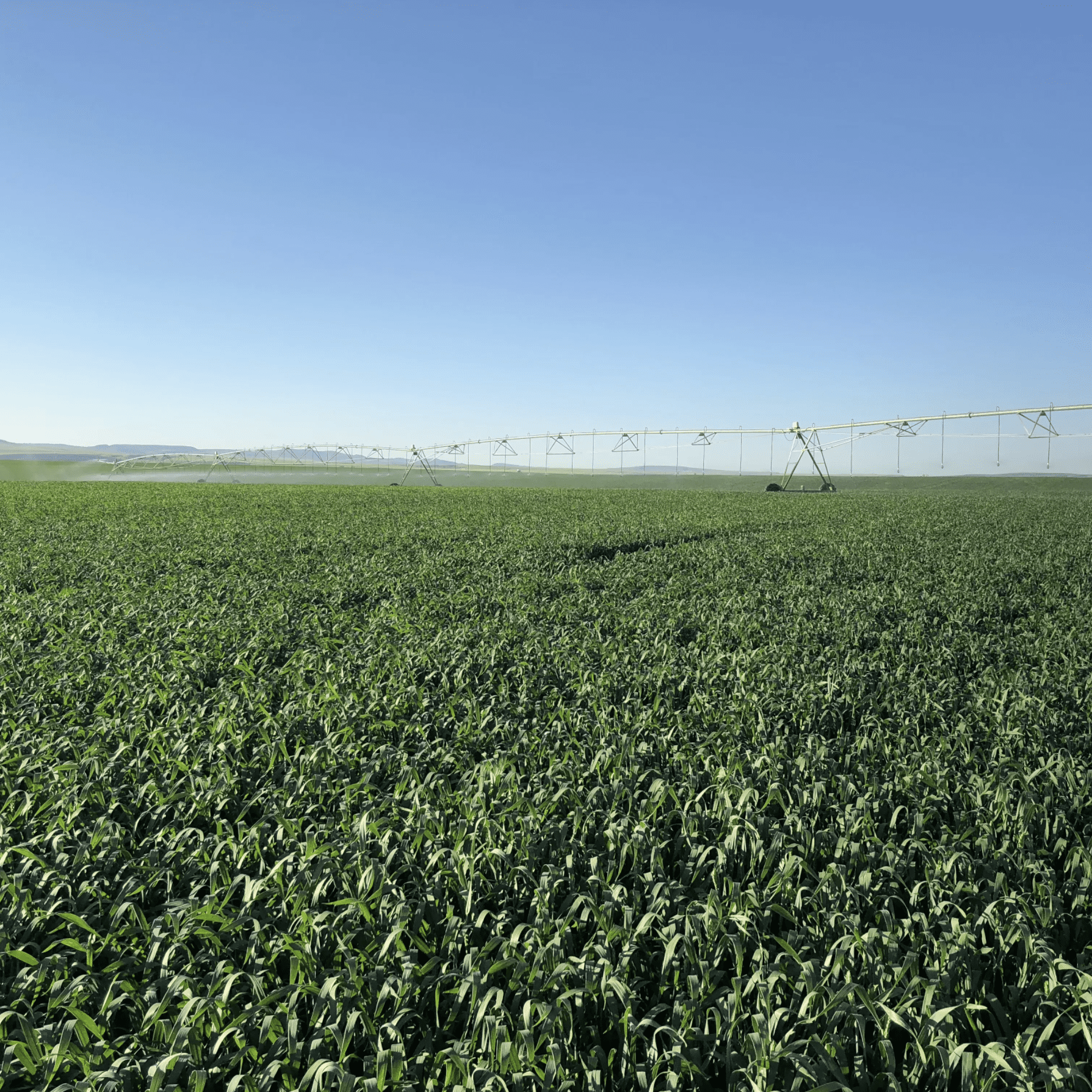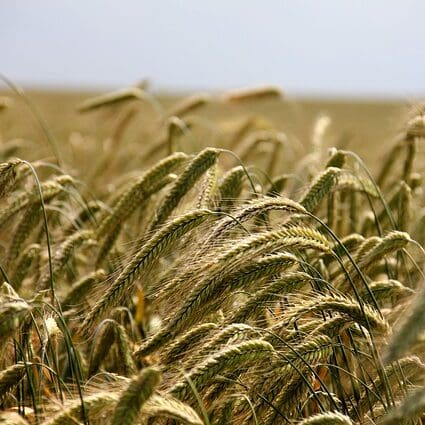Jefferson Wheat
- Semi-dwarf hard red spring wheat
- High protein
- Excellent milling and baking qualities
- White chaffed at maturity.
- Adult resistance to stripe rust
- Moderate resistance to Hessian Fly
- Resistant to lodging and drought
- Not available for online purchase.
- Call 435.283.1411 to find a dealer near you
Jefferson wheat is a semi-dwarf hard red spring wheat intended for dryland production. Jefferson can also be used as an irrigated variety. Jefferson tends to produce higher levels of protein, 13% or greater, with excellent milling and baking qualities. Sample tested in a miller’s laboratory in Ethiopia showed 17% protein. Jefferson is white chaffed at maturity. Height: 91 cm. Seed: Dark Red, Hard, Ovate, and Plump. Seed size average: 40 mg.
Jefferson wheat was originally released by the Idaho AES, USDA-ARS in 1998 for dryland production in the regions of southern Idaho and northern Utah, USA.
Excellent milling and baking qualities; adult resistance to stripe rust (Puccinia striformis); moderate resistance to Hessian Fly (Mayetiola destructor); moderate susceptibility to leaf rust (P. recondite); susceptible to Russian wheat aphid (Diuraphis noxia); resistance to lodging and drought. Production is possible in rainfall regimes below 600 mm.
***Click on the “Quick Plant Facts” tab above for more information.
Jefferson Hard Red Spring Wheat Fact Sheet
Jefferson Hard Red Spring Wheat Fact Sheet
PDF version of New Wheat Variety for Lowland Areas
Prepared By: Morrell Agro Industries, PLC
USDA National Agricultural Statistics
USDA National Agricultural Statistics
Montana 2021 Wheat Varieities PDF
Prepared By: Montana Wheat & Barley, USDA National Agricultural Statistics Servicem, Montana Field Office, Helena, MT
Beards, Dwarf Beards and Awnlettes
Making Sense of Grain Beards
What is the difference between “bearded” and “dwarf beard” and “beardless” varieties? How do I choose the one best for me?
The table below will help you visualize the different characteristics of each variety, if they have beards (or not) and why it matters. See our BEARDED GRAINS blog post for additional information.
| Species | Variety | Planting Season | Beard Expression | Comments |
|---|---|---|---|---|
| Oat | Otana | Spring | Beardless | Oats do not have a beard |
| Oat | Monida | Spring | Beardless | Oats do not have a beard |
| Oat | Intimidator | Spring | Beardless | Oats do not have a beard |
| Oat | Monico | Spring | Beardless | Oats do not have a beard |
| Oat | Magnum | Spring | Beardless | Oats do not have a beard |
| Oat | Everleaf™ Falcon Oat | Spring | Beardless | Oats do not have a beard |
| Oat | Everleaf™ 126 Oat | Spring | Beardless | Oats do not have a beard |
| Barley | Vaquero | Spring | Beardless | May express a beard up to 4/10,000 plants (.04%) |
| Barley | Sunstar Double | Spring | Bearded | Bearded forage barley |
| Barley | Claymore | Spring | Bearded | Bearded forage barley |
| Barley | Haymaker | Spring | Beardless | Forage barley |
| Barley | Lavina | Spring | Beardless | Forage barley |
| Barley | Goldeneye | Spring | Bearded | Grain barley |
| Barley | Sunstar Pride | Fall | Bearded | Fall forage barley |
| Barley | Valor | Fall | Beardless | Fall forage barley |
| Barley | Baldwin | Fall | Awnletted | Beard expression if planted after October 15 |
| Triticale | Merlin Max™ | Facultative | Beardless | Forage triticale |
| Triticale | Gunner™ | Facultative | Beardless | Forage triticale |
| Triticale | 131 | Fall | Beardless | Forage triticale |
| Triticale | 141 | Spring | Awnletted | 141 was used facultatively at high elevations |
| Triticale | Luoma | Fall | Awnletted | Forage triticale |
| Triticale | Flex 719™ | Facultative | Awnletted | Forage triticale |
| Triticale | FX 1001 | Fall | Nearly Beardless | FX 1001 may have up to 3% beard expression |
| Triticale | Motley™ | Facultative | Nearly Beardless | Forage triticale |
| Wheat | Jefferson | Spring | Bearded | Hard red grain wheat for milling |
| Wheat | Twin | Spring | Beardless | Soft white forage wheat |
| Wheat | Brundage | Fall | Beardless | Soft white forage wheat |
| Wheat | Ray | Fall | Beardless | Hard Red forage or milling wheat |
| Wheat | Willow Creek | Fall | Beardless | Hard Red forage or milling wheat |
| Rye | Rymin or VNS | Facultative | Bearded | Cereal forage rye |
| Peas | Austrian Winter Peas | Facultative | Beardless | Peas do not have a beard |
| Grain Mixture | Fall Forage Blend | Fall | Beardless | May contain awnletted varieties |
| Grain Mixture | Prosper 3 Grain Forage Mixture | Spring | Beardless | Forage mixture |
| Grain Mixture | Prosper Plus with Peas | Spring | Beardless | Prosper with forage peas added |
Helpful Links
Additional information about this product can be found on the academic websites linked below.
Synonyms
Many plants have more than one common and scientific name. We've listed a few of them below.
- Jefferson Wheat
- Triticum aestivum
Who is Great Basin Seed?
Great Basin Seed is a seed company that specializes in seed sales and consultation for home, ranch, farm, range and reclamation. We have been a leader in the seed industry since 1974.
Our History
We've been in the seed business since 1974.
What We Offer
We offer seed for home, farm, ranch, range and reclamation projects.
Meet the Gang
We have the best employees in the world! We are proud of the work they do, and trust them to serve you!
Right: Company founder Lloyd and his wife Paula Stevens in a wildflower seed production field circa 1977
Quick Plant Facts
| Scientific Name: | |
|---|---|
| Lifespan: | |
| Plant Type: | |
| Growth Season: | |
| Max Sowing Depth: | |
| Planting Rate: | |
| Best Time to Sow: | |
| Plant Height: |






